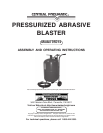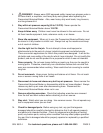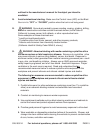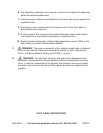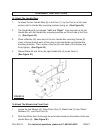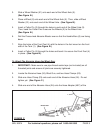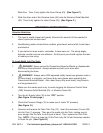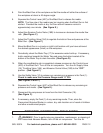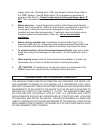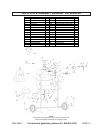
9. Dress properly. Do not wear loose clothing or jewelry as they can be caught in
moving parts. Protective, electrically non-conductive clothes and non-skid foot-
wear are recommended when working. Wear restrictive hair covering to contain
long hair.
10. Do not overreach. Keep proper footing and balance at all times. Do not reach
over or across running tools or air hoses.
11. Disconnect air hose and release any built-up air pressure. Never service the
Pressurized Abrasive Blaster or disassemble with the air hose attached. Always
release any built-up air even after disconnecting hose. Disconnect the
Pressurized Abrasive Blaster when not in use.
SKU 95014 For technical questions, please call 1-800-444-3353 PAGE 3
7. Store idle equipment. When not in use, the Pressurized Abrasive Blaster must
be stored in a dry location to inhibit rust. Always lock up the machine and keep
out of reach of children.
8. Use the right tool for the job. Do not attempt to force small equipent or
attachments to do the work of a larger industrial equipment and attachments.
There are certain applications for which this product was designed. It will do the
job better and more safely at the rate for which it was intended. Do not modify this
product, and do not use this product for a purpose for which it was not intended.
6. Keep children away. Children must never be allowed in the work area. Do not
let them handle equipment, tools, extension cords, or air hoses.
5. Stay within air pressure capacity (60 to 125 PSI). Never operate the
Pressurized Abrasive Blaster above 125 PSI.
4. WARNING! Always wear ANSI approved safety impact eye glasses under a
full face shield, a respirator, and heavy duty work gloves when operating the
Pressurized Abrasive Blaster. Also, wear heavy duty work boots, long trousers,
and long sleeve shirt.
12. Remove adjusting wrenches. Check that adjusting wrenches are removed
from the tool and work surface before attaching to an air source.
13. Stay alert. Watch what you are doing. Use common sense. Do not operate any
tool or equipment when you are tired.
14. Check for damaged parts. Before using any tool, any part that appears
damaged should be carefully checked to determine that it will operate properly
and perform its intended function. Check for alignment and binding of moving
parts, any broken parts, and any other condition that may affect proper operation.
Any part that is damaged should be properly repaired or replaced by a qualified
technician.



